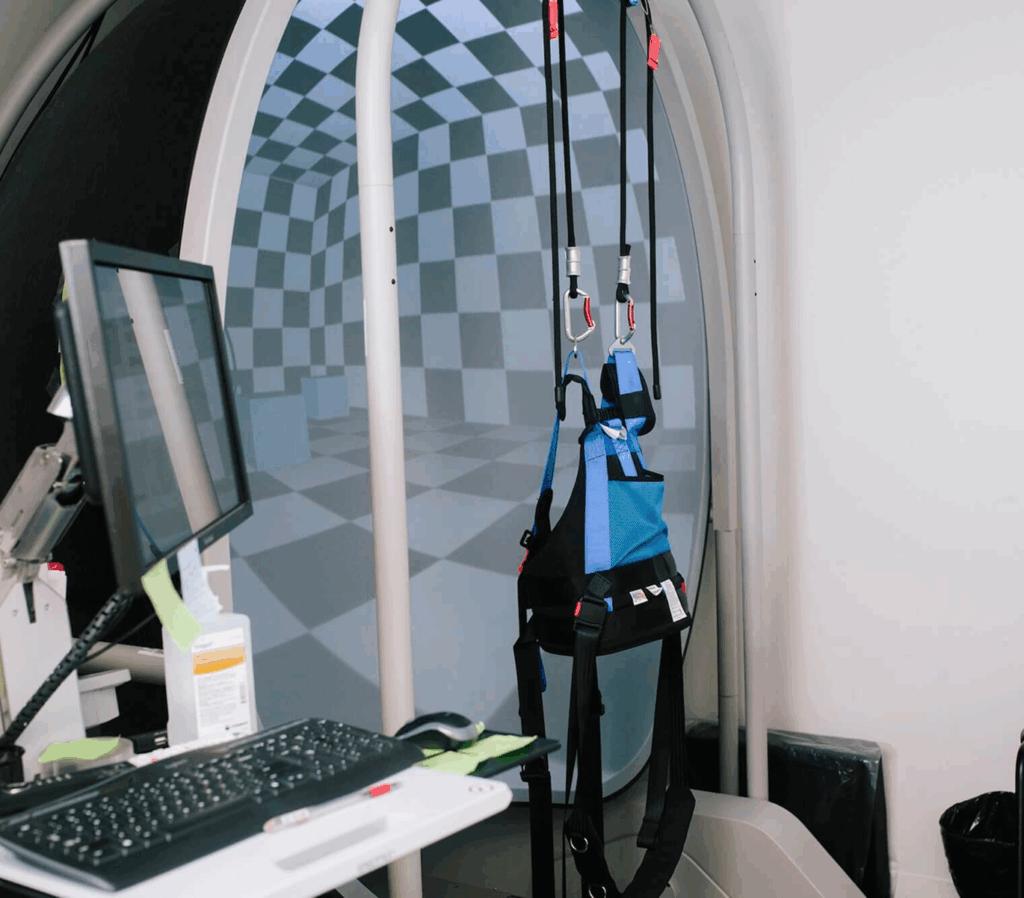Clinically proven therapies
Science
CVRT
CVRT is a non-invasive technique that uses interactive technology to support balance retraining, resulting in reduced dizziness and vertigo. It is recommended for anyone who is experiencing vertigo or ongoing feelings of instability.
The treatment is broken down into three steps – initial assessment, training sessions, and final assessment – each ranging from 40 to 90 minutes.

CVRT represents a cutting-edge approach to
addressing vestibular disorders and promoting
optimal balance and stability.
Through a combination of specialized exercises and techniques which are rigorously quantified, CVRT targets the vestibular system to enhance function, alleviate symptoms such as dizziness or vertigo, and improve overall quality of life.
What is the Vestibular System and Vertigo
The vestibular system is a collection of structures in your inner ear that regulates your sense of balance and awareness of your orientation in space. It allows you to coordinate your body movements. The vestibular system can be impacted by a concussion, contributing to symptoms such as dizziness and vertigo, as well as trouble with balance, posture, and/or vision.

What is CVRT?
Vestibular rehabilitation is a form of physical therapy used to treat vestibular disorders or symptoms. Exercises are designed to reduce or eliminate issues affecting overall stability and daily function.
One newer approach to vestibular rehabilitation is computerized dynamic posturography–assisted vestibular retraining, or “computerized vestibular retraining therapy” (CVRT) for short. This is a non-invasive technique that uses interactive technology to support balance retraining.
The technology measures how your sensory systems are helping you stay upright in different conditions. Training exercises become more challenging as you move through treatment to improve your overall stability.
Request more information
Who is a Candidate for CVRT?
Vertigo or ongoing imbalance post-concussion.
Continued reports of unsteadiness, sensitivity to movement, or feelings of dizziness persist despite undergoing vestibular rehabilitation interventions
Age associated
deterioration in balance
and stability.
Benefits of CVRT
CVRT offers many different benefits, including the following:
Improved Balance
CVRT exercises target the vestibular system, aiding in the restoration of balance and stability, which may be impaired following a concussion.
Increased Mobility
CVRT exercises help individuals improve their ability to move safely and confidently, enhancing mobility and independence in daily activities.
Enhanced Vestibular Function
CVRT promotes neuroplasticity and adaptation within the vestibular system, improving its function and reducing symptoms such as dizziness or vertigo.
Reduced Dizziness and Vertigo
By addressing vestibular dysfunction, CVRT can alleviate symptoms of dizziness, vertigo, and motion intolerance, improving quality of life for individuals with vestibular disorders.
Improvement in Quality of Life
CVRT can significantly improve quality of life for individuals with vestibular disorders, allowing them to participate more fully in daily activities and social interactions.
How does it work?
Initial Assessment and First Training Session
90 Minutes
Intake and consent forms
Three questionnaires to evaluate:
- The impact of dizziness on your daily life
- Your confidence in your balance
- Your concerns about falling
Two tests to measure:
- Your balance
- Your risk of falls and your center of gravity
Your first training session
Training Sessions
90 Minutes
These sessions are typically scheduled twice a week and involve the following
- A technician will lead you through training exercises that progress in difficulty over the course of 12 sessions total.
- During training, you will use a machine with a safety harness, interactive surround display, and moveable platform. You will need to shift your weight forward, backward, right, and left in response to visual targets on the screen. The moveable platform you are standing on will respond to and track your movements.
- The exercises you do at each session will vary, and the visual targets on screen will become more challenging.
Final Assessment and Last Training Session
90 Minutes
In your final visit you will complete your last training session and complete a final consultation with our doctor that includes:
- A review of findings from your treatment
- Completion of the same tests and questionnaires from the first session
Risks and Complications For Vertigo Treatment
While CVRT is generally considered safe and effective, there are some potential risks associated with this therapy.
Fatigue
Performing repetitive exercises during CVRT sessions may lead to fatigue, particularly in individuals who have limited stamina or other health conditions.
Nausea or Motion Sickness
The nature of CVRT exercises, which involve visual and/or vestibular stimulation, can trigger symptoms of nausea or motion sickness in some individuals, which are typically mild and transient.
Frequently asked questions
The most common symptoms of a concussion include headache, dizziness, nausea, confusion, memory problems, sensitivity to light or noise, and changes in mood or behavior.
Recovery time varies depending on the individual and the severity of the concussion. While most people recover within a few days to weeks, some may experience lingering symptoms for months or even longer.
Return to activities should be guided by a healthcare professional and based on the resolution of symptoms. It’s essential to avoid activities that could risk further injury until medically cleared.
While most people recover fully from concussions, repeated or severe concussions may increase the risk of long-term complications such as chronic traumatic encephalopathy (CTE) or post-concussion syndrome. Often, feelings of instability can cause falls in individuals who have sustained a concussion.
Strategies for preventing concussions include wearing appropriate protective gear during sports or recreational activities, practicing safe driving habits, and taking steps to minimize the risk of falls.
